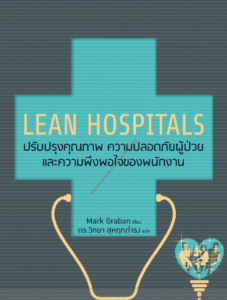I do a lot of work across the U.S., but I've also been very fortunate to work with hospitals, clinics, and health systems around the world over the past 11 years.
It started with a few trips to Canada to conduct some hospital lab assessments and Lean leadership training when I worked for a J&J hospital consulting group. Then, came an opportunity to spend about eight weeks working with a hospital north of London in 2008, a fascinating opportunity.
In recent years, I've visited and/or coached hospitals in The Netherlands, Sweden, Finland, Japan, China, and Thailand.
These are very different countries in their national cultures, of course. Their high-level, big-picture healthcare systems are designed differently (including the level of universal coverage, or lack thereof, and who pays).
But, when you look at the details of how the work is done… how healthcare is delivered… how people manage… things are more the same than they are different. In England, they said, “Same problems, different accent.”
The same has been true in my most recent stop here in Thailand – except it's same problems, different language.
What's pretty universal about healthcare in different countries?
Hear Mark read this post — subscribe to Lean Blog Audio
These are generalizations, but they are generally true:
People working in healthcare are well trained in their specialty or function and they're very smart.
They are in their line of work for reasons other than just money. They're very passionate about patient care.
But, their training and knowledge of the work is VERY silo-ed.
Nobody understands the big picture and the way the system works – what do the upstream and downstream functions and departments do?
(An analogy would be a quarterback knowing how to throw a perfect spiral, but not knowing how to play football on a team.)
There's usually very poor teamwork and coordination across departments (and this isn't the fault of individuals, it's the way the system is structured).
People quite often say they too busy to improve, and sometimes they say they are too busy to learn.
Some people will readily admit there are problems or opportunities for improvement… and some say, quite literally, “We have no problems here.”
Sometimes people are unaware of problems and opportunities and sometimes they don't want to admit that they exist (and this might not be their fault as individuals, either).
People aren't taught how to study work… they aren't taught how to observe flow and work… or how to map processes (yet alone value streams). Again, this isn't their fault.
Healthcare professionals aren't taught the basics of operations management, queuing theory, inventory management, or other helpful disciplines. They haven't been taught much about scheduling approaches and they think trying to run at 100% utilization is fine (read my post about this). Not their fault.
Highly educated professionals aren't taught how to train others in their professional skills using effective, proven methods like Training Within Industry (TWI).
People generally aren't taught how to manage or how to lead. They're expected to figure it out. Some dedicate themselves to the craft of management and they figure it out… many don't. Leaders aren't being coached or mentored in how to lead effectively.
Even though there might be statements of mission, vision, and values posted on the wall, it doesn't mean the culture really lines up with that on a daily basis.
A common problem statement is that patients are waiting too long in all of the different ways and places they could wait. That's not the fault of the individuals. It's not people being lazy or uncaring… it's system design issues.
Flow problems are not caused by a lack of effort – it's usually due to batching, silos, and a lack of coordination across value streams.
Did I mention that people are really smart and caring… and hard working?
Hospitals always have trouble finding wheelchairs and getting patients transported. But these are fixable problems.
People often think “the way it's always been” is “the way it has to be.” That's not their fault, either.
People will participate in root cause analysis… these problem solving methods work just as well in different settings.
When you give healthcare professionals time, even just a few days, to study their work and the system… to discover the current state as a team, they make AMAZING discoveries and gain a lot of insights. They've generally never had the time to do that… again, not their fault.
When taught some basic Lean methods and mindsets, it can really light a spark in people… it shows them improvement is possible and things don't have to be the way they are… things can get better.
These are not “American healthcare challenges” – they are, it seems, “healthcare challenges.”
Yes, there are cultural differences in various countries, such as the extent to which people defer to those who are older or who have more seniority. But even with that variation, things seem more similar than they are different.
While some things are universal and expected… some things are surprising… like a random Elvis impersonator performing in a hotel bar:

The Thai people have been welcoming and wonderful. As much as one can generalize, they are welcoming, kind, lovely people.
I'm honored that my book Lean Hospitals was translated into Thai (see a preview) and that some people here are reading the book and earnestly trying to use the concepts.
Please scroll down (or click) to post a comment. Connect with me on LinkedIn.
Let’s work together to build a culture of continuous improvement and psychological safety. If you're a leader looking to create lasting change—not just projects—I help organizations:
- Engage people at all levels in sustainable improvement
- Shift from fear of mistakes to learning from them
- Apply Lean thinking in practical, people-centered ways
Interested in coaching or a keynote talk? Let’s start a conversation.











Mark, maybe this is implied, but the issue is with leadership. It always is. Until leadership divorces themselves from their command and control ways – which they’ve been taught in most cases – the list you present won’t change.
Remember… How many leaders does it take to change a light bulb? None if it doesn’t want to change.
Good article. Thanks for sharing your observations.
Thanks, Hal. I agree with your comment there. It’s easier said than done. We can’t just tell leadership they have to change… they have to somehow discover that for themselves.
“Doesn’t want to change” often has a root in “Doesn’t feel the need to change.”
I’d also add that the implication is “senior leadership is responsible for the system” – that includes the culture and management system. That’s a lesson that came from Dr. Deming.
Indeed!
The following statement may be misunderstood by some, but I’ve always said, “All success and failure is laid at the feet of (senior) leadership.”
They own and are responsible for the “system.” It’s not followership’s fault. Sure there are some culprits, but that’s a minority. When leadership fully understands their role in the system dynamic and creates a like so culture, success – however you want to define it – can happen. Remember Deming’s diagram of the 7 stages of a system? It all starts with an altruistic purpose. And, that must come from leadership.
These 21 generalizations are largely the same as what one finds in higher education, and they are likewise universal. This is why I question the notion that the people who do the work are the “experts” (no disrespect intended). Let me explain what I mean in the context of professors.
Are college and university professors “experts” in their job as teachers? In Lean world, the answer would be “yes” because they are front-line workers who do the job every day. Yet, every undergraduate student experiences many professors who have poor teaching skills (many teaching defects in professors’ work) – typically about 35 out of 40 in an undergraduate degree curriculum; meaning only 3 to 5 profs were really good teachers. This suggests that professors, generally, are far less than expert at teaching than they or others think. This begs the question: Does the same phenomenon exist for most or all front-line workers, regardless of industry or occupation? Is it universal that front-line workers are less “expert” than we (or they) realize? Perhaps we have been unclear in our characterization of what “expert” means? Maybe we should be more careful and say: “They are expert in the job (method) as it is currently understood and practiced, based on how the system operates at the present time.” As leaders own the system, they thus become the limiting factor in workers’ ability to become “experts” (who make few teaching defects).
Your thoughts?
That’s a good, thought-provoking question, Bob.
It’s a good point that the front line workers are, more accurately, “the experts in how the work is done today.”
That’s different than being experts in how the work should be done.
See the story here about Toyota helping a Dallas hospital. The nurses weren’t doing the work the right way – they were setting sterile supplies down on a non-sterile bed surface. But, I think Toyota was right to look at that as a “system problem,” not a “worker problem.”
That said, the “expert telling others how to do their work” model doesn’t work. I was guilty of trying that earlier in my career and I regret that. It didn’t work. It wasn’t fully respectful to the people doing the work.
Leaders might score important political points by saying “the workers are the experts in their work.” Hopefully that leads to working TOGETHER to improve and find a better way to do the work.
Showing respect for frontline staff and respectfully engaging them is key, right? If the front line workers say, “Doing the work this way works fine for me,” a leader might need to point out the customer perspective and what NEEDS to be done… working together to define gaps and opportunities, working together to improve.